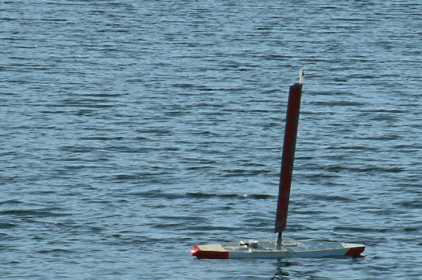Project: AROO
Technical details:
Our first sailing robot built in late 2004. It is approximately 1.5 metres long and features a 1.2 metre high aluminium wing sail. Power is provided by a 12 volt lead acid battery. The hull is built from ABS plastic and is based on a design for a model boat. It was built mainly from scrap or parts we already had, the sail is actually part of an old London bus.
The wing sail was chosen as there are fewer points of failure than on a fabric sail. We also found that it doesn't collapse in light winds like a normal sail and its very good at sailing upwind. We had a few problems with the design, the boat turned too fast for our software to respond making it difficult to sail in a straight line. The sail drive mechanism wasn't very accurate and took too long to move the sail and the compass wasn't tilt compensated so as the boat tilted it generated errors in the compass readings.
Research / Projects:
AROO's main purpose was to prove the feasability of a sailing robot and show that such a robot could be built and stood a chance of surviving for prolonged periods. We tested AROO in winds between 0 and 45 knots showing that such a robot could potentially stay at sea as long as required.
Related publications:
- [Neal, M. J.] A hardware proof of concept of a sailing robot for ocean observation, IEEE Journal of Oceanic Engineering, 2006.
- [Sauze, C.] Control software for a sailing robot, Masters Thesis, University of Wales, Aberystwyth.
